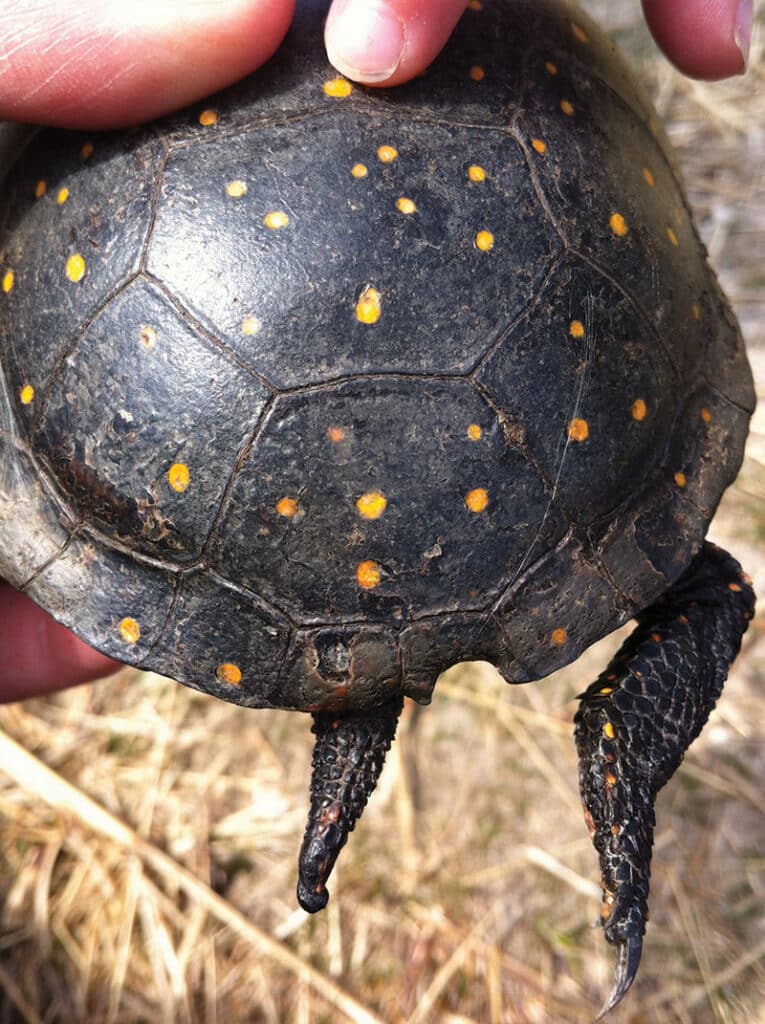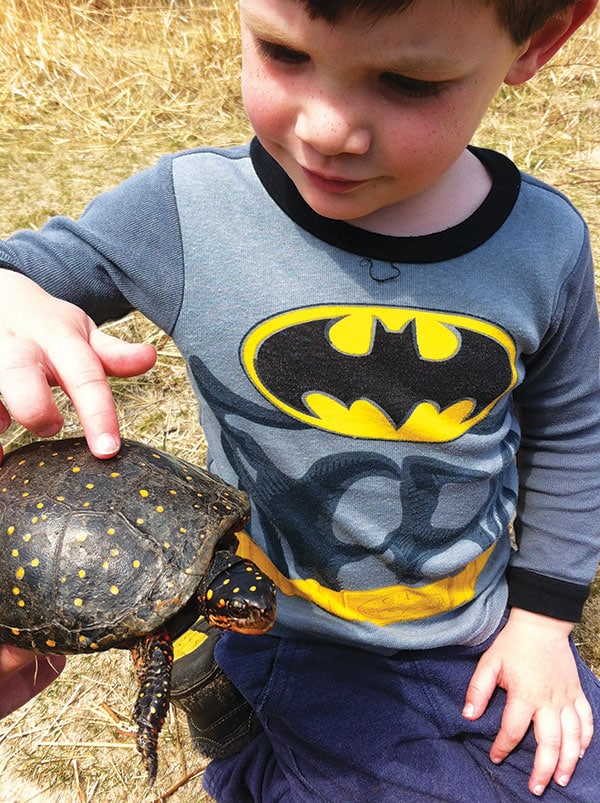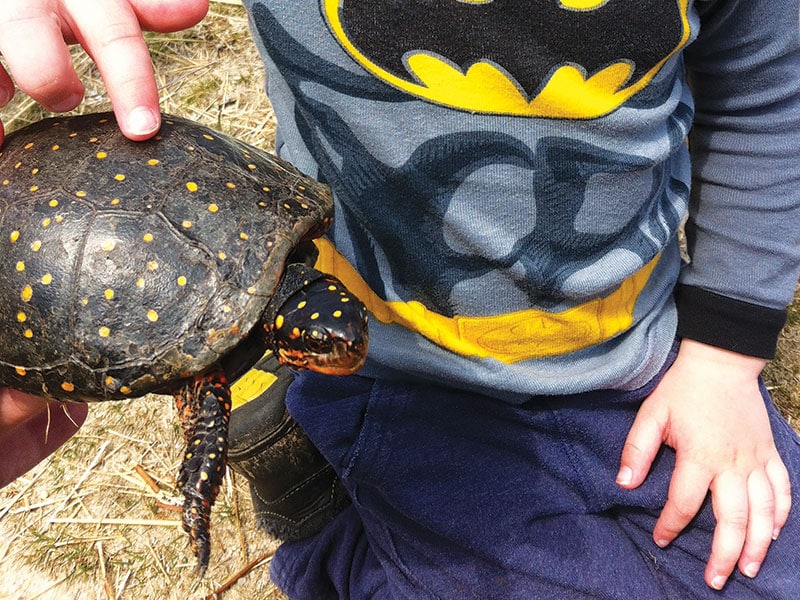by Dr. Sarah Treanor Bois
Director of Research & Education at the Linda Loring Nature Foundation
As the weather warms the island seems to spring to life. It’s not just the daffodils and birdsong. As you walk along the bike paths and travel on roads, some of our Nantucket turtles are on the move as well. Fresh out of hibernation, our smallest freshwater turtle, the Spotted Turtle (Clemmys guttata) is moving about travelling to springtime feeding and breeding grounds.
The most charismatic of Nantucket’s freshwater species (in my opinion), Spotted Turtles are relatively small (reaching only three and a half to five inches in length) with distinctive bright yellow spots dotting their otherwise black carapace (the top of their shell). As hatchlings, they usually have one spot per scute (or plate) on their shell. As they age, more spots develop. The pattern and number of spots is unique to each turtle and can be used to identify individuals.

Once listed as a Species of Special Concern under the Massachusetts Endangered Species Act, Spotted Turtles were removed from the list in 2006 due to a widespread distribution in the state and the existence of relatively stable populations in southeastern Massachusetts and the islands. State biologists believe that Nantucket’s Spotted Turtle population may be oneof the most robust and healthy in Massachusetts. Throughout most of its range, Spotted Turtles are still listed as threatened or endangered primarily due to habitat loss and fragmentation of wetland resources. Monitoring and properly managing Spotted Turtle populations throughout their range is important to the long-term persistence of the species.
One of my first conservation jobs on Nantucket was with the Nantucket Conservation Foundation (NCF) in the early 2000s. The first project I headed up at the time was monitoring Spotted Turtles at Squam Farm and other NCF properties. Monitoring involved trapping turtles with hoop nets, small box traps, or by hand, placing radio transmitters on several, and then tracking them throughout the season to gain an understanding of movement patterns across the habitat. From 2004 to 2008, NCF captured and uniquely marked almost 100 Spotted Turtles even capturing some that had been marked in the 1990s! Knowing how this species utilized the habitat helped inform management decisions about the property.
Despite a reputation for being slow, Spotted Turtles travel quite a bit throughout their annual cycle. Over the course of a year, Spotted Turtles typically visit multiple wetlands to forage, mate, thermoregulate, and overwinter, requiring frequent upland migrations and road crossings that make them especially vulnerable to road mortality. They are pretty choosy about the water bodies they inhabit, preferring shallow, muddy bogs and shrub swamps with ample sphagnum moss. They are rarely, if ever, seen in the deeper, open ponds of Nantucket like other turtles species (Snapping and Painted). Boggy ponds, fens, and sphagnum seepages, all of which can be found around Nantucket, provide suitable habitats – think of the red maple swamps of Squam Farm and Squam Swamp.
Spotted Turtles can live up to around 26 years, but many can live to 50 years or more. They reach maturity at about 10 years of age. After that, they breed every year mating in the shallow waters of vernal spring pools. Right now, in May, you may see Spotted Turtles out and about as they move from wintering grounds to the spring ephemeral swamps and vernal pools. Vernal pools are also good feeding grounds. While omnivorous, Spotted Turtles preferentially eat small, live animal prey, such as snails, worms, slugs, and spiders.
Spotted turtles are most active from April to October and may be seen singly or in groups basking in the sun. During the breeding season (May-June), males are in an active, almost frantic pursuit of females; several males may be seen simultaneously chasing one female. When the female is ready, she lets one male catch her to mate.
Once mated, females leave the shallow breeding pools to make a nest (usually in late May-June). This is when they can be seen wandering, sometimes travelling quite far from breeding pools for the “perfect” nest spot. Unfortunately, in this travel is when they are in danger of road mortality and predation. Once she finds her ideal location, she’ll begin digging in the evening. After resting, she’ll lay 3- 4 eggs in the 2-inch-deep and 2-inch-wide nest. She then covers the eggs to disguise the nest and smooths the dirt by dragging her body over it. Peak nesting season on island is during the month of June. Nests can be in fields or residential yards, areas where the nest will get sunlight throughout the day to incubate the eggs. They prefer patches of bare sandy soil when available – and we have plenty here on Nantucket – which means a nest can be almost anywhere. If you find a nesting female, the best thing to do is to keep people and animals away from the area until she’s done nesting, which can take several hours.
By late August/early September the hatchlings emerge about 1 inch in size. The wee ones travel to wet grass or leaves looking for food. At this size, their only protection from predation is their camouflage. Many end up as a meal for a predator with only a small fraction reaching adulthood.

The Spotted Turtle is still considered an at-risk species that was recently petitioned for listing under the Endangered Species Act and is currently ‘Under Review’ for listing by the U.S. Fish and Wildlife Service (USFWS). The Northeast Spotted Turtle Working Group is currently gathering data regionally to inform the USFWS’s decision. Danielle O’Dell of the Nantucket Conservation Foundation is part of this working group. NCF has continued sampling Spotted Turtles at multiple sites to inform various restoration efforts. These include Medouie Creek (salt marsh restoration) and more recently at Windswept Cranberry Bogs where a major restoration effort is in the planning phase. In 2019, funds from the American Turtle Observatory allowed NCF to purchase transmitters to track turtles at Windswept. Understanding their habitat use and winter hibernation will help in the planning and implementation of restoration efforts, O’Dell said. Data from sampling efforts of NCF and the rest of the working group will be used to inform the USFWS decision on listing Spotted Turtles expected in 2022.
You may be seeing more turtles this time of year (not just Spotteds) as many are travelling in search of food, mates, and nesting grounds. The number one thing you can do to help protect Spotted Turtles (and other turtle species) is to stop when they are in the road and allow them to cross. If it’s safe to do so, you can move the turtle across yourself, but always move it in the direction it was traveling. They know where they are going!
Here are a few things you can do to help protect these wonderfully wild and charismatic species:
You can help the spotted turtle, and many other wildlife species, by conserving wetland habitat wherever you can.
Leave turtles in the wild. Remember that even though they are cute, Spotted Turtles cannot be kept as pets. Massachusetts is strict with pet laws.
Do not disturb turtles nesting in yards or gardens.



